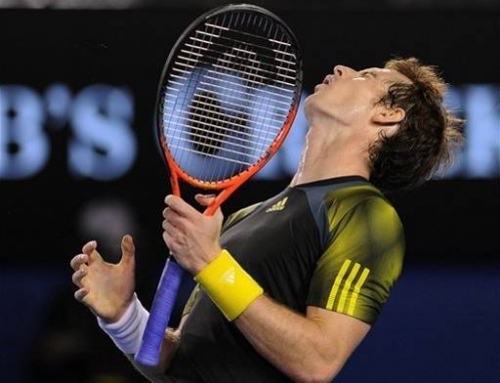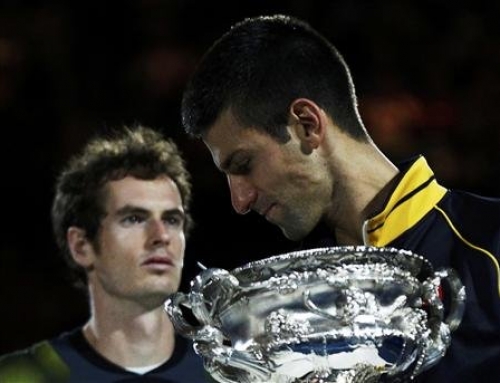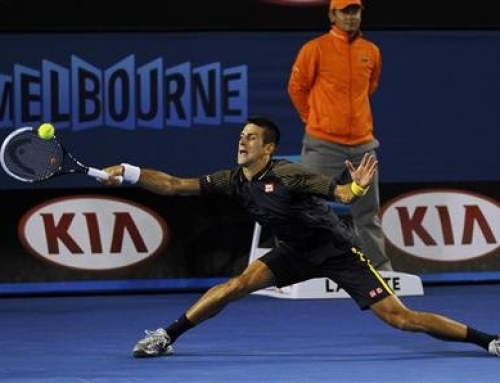Ever since the draw came out, a draw that was partly determined by Murray’s slip in the rankings from 4 to 5, and Murray found himself in the same quarter as Nadal, this quarterfinal matchup was the most hotly anticipated. On the one hand, there was Andy Murray. Long touted as the most talented of the up-and-coming players, Murray has long played to the beat of his own drum. Endless critics chastised him, saying he had to stop being so defensive, so passive.
Early rounds didn’t allay fears, even as Murray was winning them handily, nary dropping a single set in four rounds. Experts wondered if he could even pound the ball. He seemed stubbornly attached to his finesse play that sent soft shots and goaded his opponents to take a swipe at it. I dare you, Murray’s game would say. And this had lead to a series of disappointments. Last Australian Open, Murray lost in the quarterfinals to Verdasco, even though he had been sick (suck it up!). The French Open quarterfinals was actually his best result on a clay surface. His Wimbledon semifinal was an improvement over the previous year, even as local Brits expected him to win the big “W”. Murray sought to reinforced the idea by being decked out in Fred Perry’s, honoring the 100th anniversary of the birth of the last British male to win Wimbledon (whew!).
Murray again pointed to the US Open as the tournament he most wanted to win, the one he felt most capable of winning, and the one he had done the best at, reaching the final in 2008. It also turned out to be his biggest disappointment, losing in the fourth round to Marin Cilic. In hindsight, that loss may have been like many of Murray’s losses–to players that appear destined for better things. One only has to recall his first round exit in the 2008 Australian Open to, wait for it–Jo-Wilfried Tsonga.
While questions remained about Andy Murray’s heart and aggressiveness, there were also questions about his opponent, Rafael Nadal.
A year ago, Rafael Nadal was on top of the world. He had won his fourth French title in 2008 without dropping a set. He had finally broken through at Wimbledon, winning an epic match, 9-7 in the fifth. He had had his best US Open, a loss to Andy Murray in four sets in the semifinals. And he finally met Roger on a hardcourt in the 2009 Australian Open, another five set epic that saw Roger choke away an early brek in the fifth, then get broken again.
Rafa was already world number 1, and he headed into the clay season as he normally does, steamrolling through opponents. He won Monte Carlo. He won Barcelona. He won Rome. By the time he won his semifinal encounter with Novak Djokovic in Madrid, he had complete a trilogy of wins over Djokovic, the semifinal win being the creme de la creme. But that marathon of match, plus Roger Federer’s new tactics in the final gave Federer a rare clay victory over Nadal, and whispers began that maybe this was Roger’s year. Maybe he had figured out how to beat his Mallorcan rival who had time and again, bested the Basel wunderkind on clay.
Then, the unthinkable happened. Rafa didn’t win the French. Tall, blond, and Swedish, Robin Soderling took the game to Nadal in a fourth round match. Nadal didn’t seem like Nadal. He retreated feet behind the baseline, looped high shots up, while Soderling, playing on his weakest surface kept pounding the ball, making Nadal pay for his inferior court position. Soderling not only took games off Nadal, a feat he was unable to accomplish weeks earlier in their previous meeting, but took sets. And even when it looked like Nadal might come back and make a match of it, Soderling soldiered on.
Nadal would then talk about the pain in his knees even as his loss opened the doors for Federer to win the only Slam that had eluded him. He had tendinitis in both knees and he publicly wondered whether he’d be able to play Wimbledon. He skipped Queen’s where he had been defending champ, and when he lost in an exhibition to Lleyton Hewitt and Stan Wawrinka, he made an announcement that he was heading back to Spain to recover and not defending his title.
This time off started a cascade of ranking changes that had seemed like bedrock with Rafa and Roger having held the number 1 and 2 spots for years. With the French win, Roger would take over number 1, a position he still holds today. As Wimbledon passed and the US hardcourt season started again, Rafa would even lose the number 2 ranking to Andy Murray.
Rafa would return again at Montreal. He played down expectations. He hadn’t played in an official capacity in a little over two months. He would reach the quarterfinals and lose to Juan Martin del Potro. This loss wasn’t entirely unexpected. del Potro had been improving by leaps and bounds and even had a victory earlier in the year in Miami where he eked out a 3rd set tiebreak to claim his first victory over the-then world number 1.
Then, in Cincinnati, he’d lose to Djokovic in the semifinals. After a trio of heartbreaking losses to Nadal, Djokovic was finally playing Nadal on his best surface and he took full advantage, even if Nadal might not have been 100%.
Nadal would repeat his US Open semifinal run, but this time run into a buzzsaw. Juan Martin del Potro would hand Nadal one of his worst losses ever, a 6-2, 6-2, 6-2 beatdown, leaving Nadal wondering where his game was.
To be honest, if it were anyone besides Nadal, his post US Open results were actually quite good. He wasn’t winning any titles, but he was reaching the semifinals and reaching finals. He was losing to good players.
His worst moment occurred in London in the ATP World Tour Finals. In three round robin matches, he won zero. That’s not only zero matches, but zero sets. Soderling beat him (again). Then, Djokovic. Then, Davydenko. Davydenko had already beaten him in Shanghai, so his fortunes against the best players were already improving. The claim was that Nadal had lost weight to protect his knees and had altered his forehand and service motion, presumably to let him play with fewer injuries.
Nadal then rested and recovered in the one month allotted to all pros. This time off always seemed to rejuvenate Nadal. His game was always best in the first six months of the year until just after Wimbledon. 2009 was then an anomaly, one where his body broke down much sooner, and threw the rest of his year in disarray. To be fair, disarray for Nadal would be a stellar year for any other player outside the top 5. We’ve just become accustomed to the world number 1 playing dominating tennis.
Nadal started off in a 6-man exhibition in Abu Dhabi and beat Robin Soderling in the finals. He then went to Doha where he looked like he’d win his first title since Rome. He started off with a 6-0 shellacking of Davydenko. But this Davydenko seemed mentally tougher. He started to win games then took the second set tiebreak even deflecting match points against him. In the third set, it was Nadal who mentally broke down and Davydenko that held tough. By any other standard, this was still a great match, but by Nadal’s high standards, it was disturbing. Nadal’s biggest strength has always been his fight. When Nadal fights, he wins the big points and he wins matches. For Nadal to lose such a match was not something he was used to. He had to be happy about one thing: he was hitting the ball much better than London.
This leads us to about a week ago. Was Nadal ready to defend his title? Even when Nadal isn’t 100%, he beats players ranked outside the top 10. He can do that even on bad knees. Nadal won his first two rounds in straight sets as he was expected to do. It took four sets to beat Philipp Kohlschreiber, but Kohlschreiber knows how to play aggressively against Nadal. Although he had never won, he had taken sets off. This wasn’t so unexpected.
Then, he lost a set to Ivo Karlovic. To be fair, the break game was one of the flukiest game ever, including a series of netcord points by Karlovic that lead to an easy point at net, and a weird bloop return that landed so short that it could almost be considered a drop shot. Otherwise, Rafa seemed to be hitting pretty well. Still, if you had watched his final against Federer a year ago, you had to marvel how much better he moved, how much more solid he played. His level hadn’t dropped significantly, but it had dropped.
And that lead to last night. On the one hand, Andy Murray, who has had expectations placed on his head not only by a title-hungry Britain, but by nearly every tennis sportswriter. The Nadal camp even publicly stated that Murray was the favorite coming into this match and how talented he was. Perhaps a bit of gamesmanship? Or just respect for his opponent?
And on the other hand, Rafael Nadal, who was still playing maybe 85%. Was that good enough? For all his losses to players after the French Open, the one player he didn’t play was Andy Murray. Davydenko might have walked into the match confident. Djokovic, too. Certainly Juan Martin del Potro if he hadn’t already lost to Andy Roddick.
When the match started, it was quickly clear that Andy Murray has a strategy for about 90% of his opponents, and he has one for Rafael Nadal. Murray doesn’t dink and dunk with Nadal. Nadal is too quick, too accurate, too powerful for that kind of hitting. Murray had a whole host of surprises for Nadal. First, Murray was going to attack the Nadal serve. Second, he would hit hard sharp angle backhands to push Nadal off the court. Third, he’d go for bigger shots on both sides, aiming for winners down-the-line on both sides. Fourth, he’d serve and volley! Fifth, he’d try to use his serve to advantage.
Although Murray came out firing, it was Nadal that was threatening to break early on. Yet, Murray’s aggression, his surprise forays to the net, his big serves were enough to withstand the early challenges to his serve. But then, he fell a break at 1-all to Nadal. Not exactly what he had hope for. But this is the new Murray, and he plays the next game aggressively, getting to 0-40 on Nadal’s serve. Although Nadal gets a few points, Murray finally breaks and it’s back on serve. At 2-all, Murray again found himself in trouble, down 0-40, and had to work hard to get out of this game to 3-2. Murray would then break a second time to a 4-2 lead. Each player would hold from then on, with Murray closing out the set 6-3.
One set down. But the second set was critical. If Murray could win this, he’d put Nadal in a chokehold, and his chances of winning would almost be forgone. Nadal had to win this set. At 3-2, however, play was delayed for nearly 10 minutes. It was Australia Day, don’t you know? Sort of the Labor Day meets July 4 in Australia. The holiday was only 17 years old having started in 1994. The ten minute fireworks has to be among the shortest for this kind of celebration.
Murray and Nadal were trying to keep warm, stretching, running around, then briefly heading into the lockers before coming out a minute or two later. The delay seemed to put Murray off his game, and he was immediately broken by Nadal to 4-2. But, don’t you know? This is the new Murray. Murray went back to work and had Nadal down 15-40 and would take the break back. The two would trade holds all the way up to the tiebreak.
This was do-or-die for Andy Murray. Was he ready to meet destiny head on? Murray would take an early lead in the tiebreak, one that he stretched out to a 6-1 lead. Nadal would win one more point, but Murray would seal the deal, and take the second set.
Murray would take the first game of the third set when Nadal called for a trainer midway through his first service game. Nadal’s knees seem to be bothering him. Once play resumes, Murray works to secure a break. Nadal then has a chance to break Murray at 30-40, but Murray dismisses the challenge with an ace. Although Rafa gets another chance to break, Murray again serves himself out of trouble, and reaches 3-0.
And with that, Nadal retires. He says his knees are bothering him, and Murray finds himself in the semifinals, having passed the first of a three part test.
Part 2 is Marin Cilic in the semifinals, the player who knocked him out of the US Open in the fourth round. Marin has logged the most hours of any player in the tournament, but is still a dangerous player. Meanwhile, Murray has yet to drop a set.
The match answers one question: is Murray ready to win? And it raises another question. What will happen to Rafael Nadal?
In a match that was interrupted by fireworks, Murray put a display of his own.
And it’s only the quarterfinals.






![[Aussie Open Final] Can Andy Murray beat Novak Djokovic?](https://www.essentialtennis.com/wp-content/uploads/2013/01/20130126andy-500x383.jpg)
![[Day 13, Aussie Open] Bryan brothers win 13th Slam with Aussie doubles title, Kyrgios wins boys title](https://www.essentialtennis.com/wp-content/uploads/2013/01/20130125bryan-500x383.jpg)